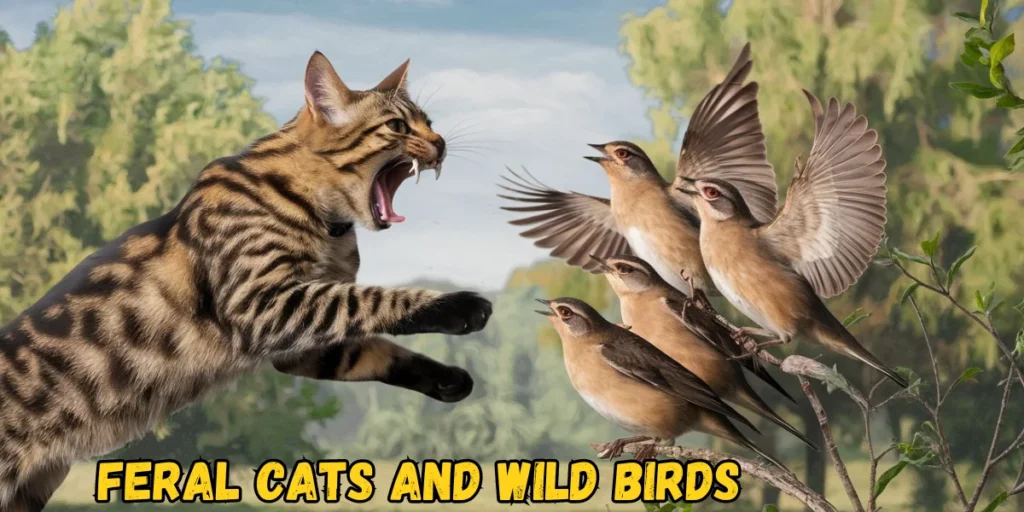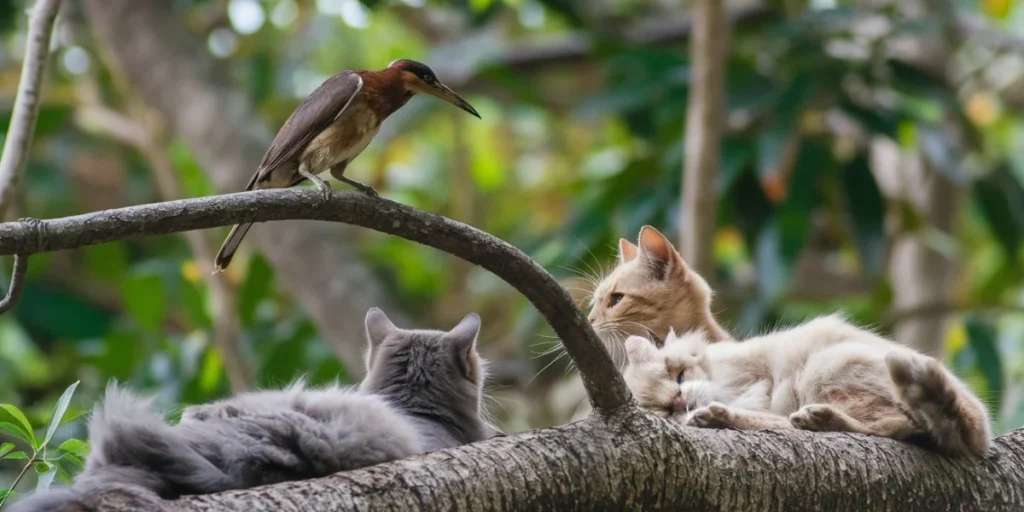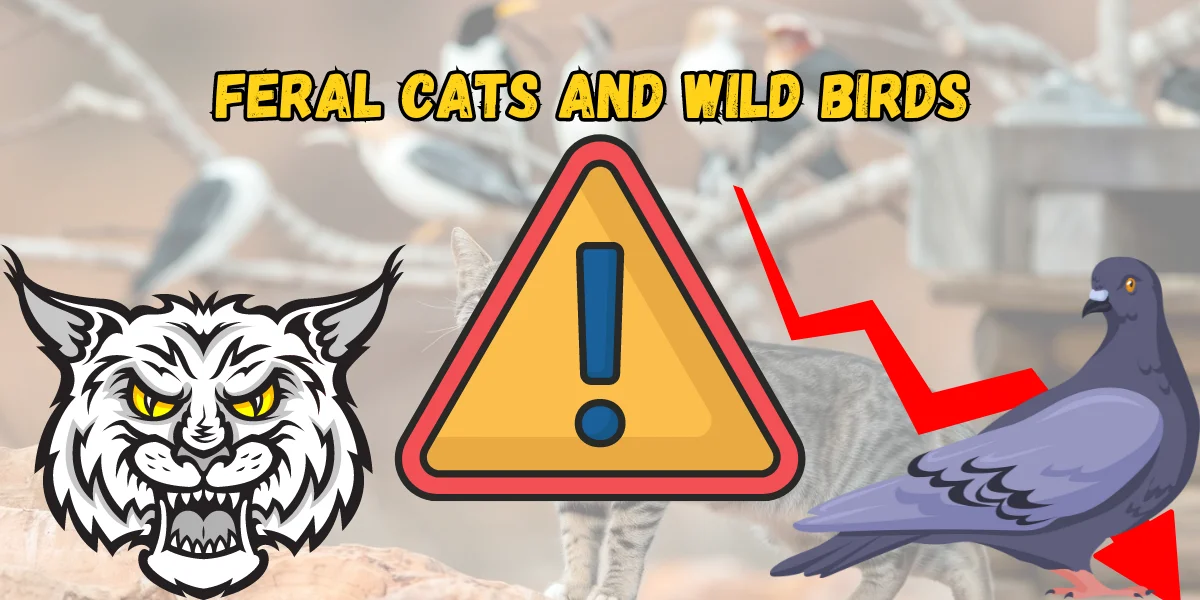Feral Cats and Wild Birds
Feral cats can harm wild birds by hunting and killing them. Since feral cats live outdoors and don’t rely on people for food, they often hunt birds for survival. This can reduce the number of wild birds and disrupt the balance of nature. Protecting birds from feral cats is important to keep ecosystems healthy.
Feral Cats and Wild Birds: A Deep Dive into Their Impact on Each Other
Feral cats are domestic cats that live outdoors without direct human care, often forming colonies in urban or rural environments. Wild birds, on the other hand, are essential to the balance of nature, serving roles such as pest control, seed dispersal, and being part of the food chain. However, feral cats pose a significant threat to wild bird populations around the world. This article explores the complex relationship between feral cats and wild birds, discussing how feral cats affect bird populations and what can be done to reduce the impact.
What Are Feral Cats?
Feral cats are not wild animals by nature, but rather domestic cats that live outside without human contact or care. These cats might be born in the wild or abandoned by their owners, leading them to adapt to an outdoor lifestyle. Unlike pet cats, feral cats are usually wary of humans and live in colonies where they hunt for food. Their primary diet consists of small animals, such as rodents, insects, and unfortunately, birds.
Why Are Wild Birds Important?
Wild birds are an essential part of ecosystems. They help control insect populations, pollinate plants, and spread seeds, which promotes plant growth. Birds are also a food source for many predators and play a key role in maintaining the balance of natural ecosystems. The reduction in bird populations can lead to imbalances that affect not only plants and animals but also humans who rely on ecosystems for farming and other activities.

The Hunting Instinct of Feral Cats
Cats are natural hunters, and this instinct remains strong even in feral cats. Though they may eat commercial cat food if it’s available, feral cats hunt primarily to survive. Birds, being smaller and often abundant, become easy targets. The problem is that feral cats tend to kill more birds than they need to eat, as their hunting drive is based on instinct, not just hunger.
Feral cats are responsible for killing billions of birds worldwide each year. The exact number varies by region, but research shows that in places with high feral cat populations, bird numbers decrease drastically.
How Feral Cats Impact Bird Populations
- Direct Predation: The most obvious way feral cats impact bird populations is through direct predation. Feral cats kill wild birds for food, but they may also hunt them for sport, especially during nesting season when birds are most vulnerable. This leads to a decrease in adult birds as well as the destruction of nests and eggs.
- Disruption of Nesting Sites: Feral cats often disturb bird nesting sites. Some bird species build nests on or near the ground, making them easy prey for cats. When a bird’s nest is destroyed, it significantly reduces the chances of raising healthy offspring, further contributing to declining bird numbers.
- Stress and Fear: Even if a feral cat does not catch a bird, its mere presence can cause stress among bird populations. Birds may abandon nests or avoid areas where they sense danger, leading to lower reproduction rates.
- Indirect Effects on the Ecosystem: The decline in bird populations due to feral cat can have a ripple effect on the ecosystem. For instance, birds that help control insect populations may not be present in sufficient numbers, leading to increased pest problems. This can affect plant health and agricultural productivity, creating a chain of negative consequences.
The Role of Human Activity in the Problem
Human activity plays a significant role in the feral cat problem. Many feral cats are the result of irresponsible pet ownership, such as abandoning cats or failing to spay and neuter them. As these cats reproduce, their populations grow, leading to an increased number of predators hunting wild birds.
Urban expansion and habitat destruction have also contributed to the problem. As natural bird habitats disappear, birds are forced to live closer to human settlements, where feral cat colonies are often found. This overlap makes birds more vulnerable to predation.
Efforts to Control Feral Cat Populations
Many efforts have been made to control feral cat populations, with the aim of protecting wild birds and other wildlife. Below are some of the methods used:
- Trap-Neuter-Return (TNR): This method involves capturing feral cats, spaying or neutering them, and then releasing them back into the wild. While this doesn’t immediately reduce the population of feral cats, it prevents further reproduction and can help control the number of cats over time.
- Cat Sanctuaries: Some organizations create sanctuaries where feral cats are taken off the streets and cared for in enclosed environments. This prevents them from hunting wild birds while still providing the cats with a safe place to live.
- Adoption Programs: Feral cats that are young or socialized can sometimes be adopted as pets, which reduces their impact on bird populations. However, many feral cats are too wild to be easily rehomed.
- Educational Campaigns: Raising awareness about the importance of spaying and neutering pet cats, as well as encouraging responsible pet ownership, is another key strategy. When pet owners keep their cats indoors or under supervision outdoors, the chance of their pets contributing to bird population declines decreases significantly.

Challenges in Solving the Feral Cat Problem
While efforts like TNR and adoption programs are helpful, solving the feral cat problem is a complex issue. Some challenges include:
- Public Opposition: Many people are fond of cats and may oppose efforts that involve removing or controlling feral cat populations. There is often debate over the best methods to reduce feral cat numbers, as some people see them as an important part of the local wildlife.
- Lack of Resources: TNR programs and sanctuaries require significant funding and resources. Many areas don’t have the capacity to run these programs at a scale that would make a meaningful difference.
- High Reproduction Rates: Cats reproduce quickly, with one female capable of having multiple litters per year. This makes controlling feral cat populations difficult, as even with TNR programs, new kittens are constantly being born.
What Can Be Done to Protect Wild Birds?
While controlling feral cat populations is an important step in protecting wild birds, there are also other actions that can be taken:
- Create Bird-Friendly Spaces: Homeowners can create environments that make it harder for cats to hunt birds. For example, placing bird feeders in areas that are difficult for cats to access or planting dense vegetation can provide birds with safer spaces.
- Keep Pet Cats Indoors: Pet owners can help protect wild birds by keeping their cats indoors or building enclosed outdoor spaces, sometimes called “catios,” where cats can enjoy the outdoors without posing a threat to wildlife.
- Support Bird Conservation Groups: Many organizations work to protect bird populations from various threats, including feral cats. Supporting these groups through donations or volunteer work can help promote bird conservation efforts.
- Responsible Cat Ownership: Spaying or neutering pet cats, keeping them indoors, and providing them with stimulating activities to reduce their hunting instincts can all help protect wild birds.
- Advocacy for Stronger Wildlife Protection Laws: Advocacy for laws that protect birds and wildlife from domestic and feral animals can also make a significant impact. This can include regulations that encourage responsible pet ownership, support for conservation areas, and more robust TNR programs.
Success Stories: Places Where Bird and Cat Protection Coexist
There are some success stories where the balance between feral cats and wild bird populations has been managed effectively:
- New Zealand: New Zealand is home to many endangered bird species that are highly vulnerable to feral cats. The country has implemented strict measures, including cat-free areas and sanctuaries, to protect its bird populations. Some regions even have legislation that requires pet cats to be kept indoors at night.
- Hawaii: Hawaii is another region with unique bird species that are threatened by feral cats. Here, organizations are working hard to control feral cat populations through a combination of TNR programs and the creation of protected areas for birds.
- Florida Keys: In the Florida Keys, efforts have been made to protect native bird species like the Key West Quail-Dove from feral cat predation. Local groups have set up TNR programs, as well as public education campaigns, to reduce the feral cat population while safeguarding bird habitats.

Conclusion: Balancing the Needs of Both Cats and Birds
The relationship between feral cats and wild birds is a delicate and complicated one. While feral cats are not native wildlife, they have become a part of many ecosystems, often at the expense of wild birds. Striking a balance that allows both species to coexist without harm requires thoughtful, humane solutions.
Efforts to control feral cat populations, protect bird habitats, and encourage responsible pet ownership are essential in addressing this issue. It is possible to create a world where feral cats and wild birds both have a place, but it will require continued action and collaboration from governments, wildlife organizations, and everyday people.
Ultimately, protecting wild birds from feral cats is not just about saving individual species, but about maintaining the balance of ecosystems that benefit all life on Earth, including humans.
FAQs
1. What are feral cats?
Feral cats are domestic cats living in the wild without human care.
2. How do feral cats affect birds?
Feral cats hunt birds, reducing bird populations.
3. Can feral cats be controlled?
Yes, methods like Trap-Neuter-Return (TNR) help manage populations.
4. Why are wild birds important?
Wild birds help control pests and support ecosystem balance.
5. How can we protect birds from feral cats?
Keep pet cats indoors, support TNR programs, and create bird-friendly spaces.
6. Do all cats harm birds?
Not all, but feral and outdoor cats pose a higher threat to birds.

2 thoughts on “Feral Cats and Wild Birds: Feral Cats vs Birds”